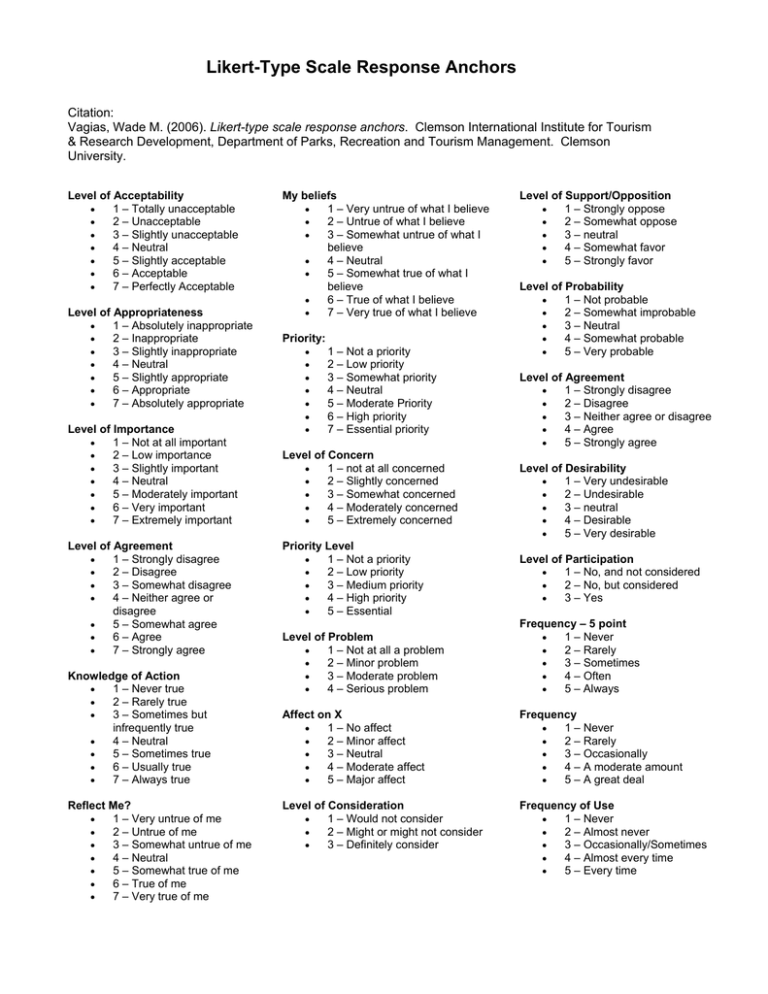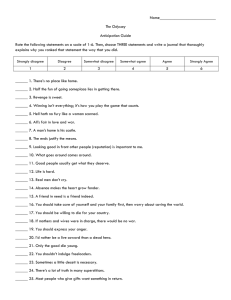Likert-Type Scale Items
advertisement

Likert-Type Scale Response Anchors Citation: Vagias, Wade M. (2006). Likert-type scale response anchors. Clemson International Institute for Tourism & Research Development, Department of Parks, Recreation and Tourism Management. Clemson University. Level of Acceptability • 1 – Totally unacceptable • 2 – Unacceptable • 3 – Slightly unacceptable • 4 – Neutral • 5 – Slightly acceptable • 6 – Acceptable • 7 – Perfectly Acceptable Level of Appropriateness • 1 – Absolutely inappropriate • 2 – Inappropriate • 3 – Slightly inappropriate • 4 – Neutral • 5 – Slightly appropriate • 6 – Appropriate • 7 – Absolutely appropriate Level of Importance • 1 – Not at all important • 2 – Low importance • 3 – Slightly important • 4 – Neutral • 5 – Moderately important • 6 – Very important • 7 – Extremely important Level of Agreement • 1 – Strongly disagree • 2 – Disagree • 3 – Somewhat disagree • 4 – Neither agree or disagree • 5 – Somewhat agree • 6 – Agree • 7 – Strongly agree Knowledge of Action • 1 – Never true • 2 – Rarely true • 3 – Sometimes but infrequently true • 4 – Neutral • 5 – Sometimes true • 6 – Usually true • 7 – Always true Reflect Me? • 1 – Very untrue of me • 2 – Untrue of me • 3 – Somewhat untrue of me • 4 – Neutral • 5 – Somewhat true of me • 6 – True of me • 7 – Very true of me My beliefs • 1 – Very untrue of what I believe • 2 – Untrue of what I believe • 3 – Somewhat untrue of what I believe • 4 – Neutral • 5 – Somewhat true of what I believe • 6 – True of what I believe • 7 – Very true of what I believe Priority: • • • • • • • 1 – Not a priority 2 – Low priority 3 – Somewhat priority 4 – Neutral 5 – Moderate Priority 6 – High priority 7 – Essential priority Level of Concern • 1 – not at all concerned • 2 – Slightly concerned • 3 – Somewhat concerned • 4 – Moderately concerned • 5 – Extremely concerned Priority Level • 1 – Not a priority • 2 – Low priority • 3 – Medium priority • 4 – High priority • 5 – Essential Level of Support/Opposition • 1 – Strongly oppose • 2 – Somewhat oppose • 3 – neutral • 4 – Somewhat favor • 5 – Strongly favor Level of Probability • 1 – Not probable • 2 – Somewhat improbable • 3 – Neutral • 4 – Somewhat probable • 5 – Very probable Level of Agreement • 1 – Strongly disagree • 2 – Disagree • 3 – Neither agree or disagree • 4 – Agree • 5 – Strongly agree Level of Desirability • 1 – Very undesirable • 2 – Undesirable • 3 – neutral • 4 – Desirable • 5 – Very desirable Level of Participation • 1 – No, and not considered • 2 – No, but considered • 3 – Yes Level of Problem • 1 – Not at all a problem • 2 – Minor problem • 3 – Moderate problem • 4 – Serious problem Frequency – 5 point • 1 – Never • 2 – Rarely • 3 – Sometimes • 4 – Often • 5 – Always Affect on X • 1 – No affect • 2 – Minor affect • 3 – Neutral • 4 – Moderate affect • 5 – Major affect Frequency • 1 – Never • 2 – Rarely • 3 – Occasionally • 4 – A moderate amount • 5 – A great deal Level of Consideration • 1 – Would not consider • 2 – Might or might not consider • 3 – Definitely consider Frequency of Use • 1 – Never • 2 – Almost never • 3 – Occasionally/Sometimes • 4 – Almost every time • 5 – Every time Frequency – 7 point • 1 – Never • 2 – Rarely, in less than 10% of the chances when I could have • 3 – Occasionally, in about 30% of the chances when I could have • 4 – Sometimes, in about 50% of the chances when I could have • 5 – Frequently, in about 70% of the chances when I could have • 6 – Usually, in about 90% of the chances I could have. • 7 – Every time Amount of Use • 1 – Never use • 2 – Almost never • 3 – Occasionally/Sometimes • 4 – Almost every time • 5 – Frequently use Level of Familiarity • 1 – not at all familiar • 2 – Slightly familiar • 3 – Somewhat familiar • 4 – Moderately familiar • 5 – Extremely familiar Level of Awareness • 1 – not at all aware • 2 – Slightly aware • 3 – Somewhat aware • 4 – Moderately aware • 5 – Extremely aware Level of Difficulty • 1 – Very difficult • 2 – Difficult • 3 – Neutral • 4 – Easy • 5 – Very easy Level of Satisfaction – 5 point • 1 – Not at all satisfied • 2 – slightly satisfied • 3 – moderately satisfied • 4 – Very satisfied • 5 – Extremely satisfied Likelihood • 1 – Extremely unlikely • 2 – unlikely • 3 – Neutral • 4 – likely • 5 – Extremely likely Level of Satisfaction – 7 point • 1 – Completely dissatisfied • 2 – Mostly dissatisfied • 3 – Somewhat dissatisfied • 4 – neither satisfied or dissatisfied • 5 – Somewhat satisfied • 6 – Mostly satisfied • 7 – Completely satisfied Level of Detraction • 1 – detracted very little • 2– • 3 – Neutral • 4– • 5 – Detracted very much Good / Bad • 1 – Very negative • 2– • 3 – Neutral • 4– • 5 – Very positive Barriers • • • • 1 – Not a barrier 2 – Somewhat of a barrier 3 – Moderate barrier 4 – Extreme barrier Level of Satisfaction – 5 point • 1 – Very dissatisfied • 2 – dissatisfied • 3 – unsure • 4 – satisfied • 5 – Very satisfied Level of Quality – 5 point • 1 – Poor • 2 – Fair • 3 – Good • 4 – Very good • 5 – Excellent Comparison of Two Products • 1 – much worse • 2 – somewhat worse • 3 – about the same • 4 – somewhat better • 5 – much better Level of Responsibility • 1 – Not at all responsible • 2 – somewhat responsible • 3 – mostly responsible • 4 – completely responsible Level of Influence • 1 – not at all influential • 2 – slightly influential • 3 – somewhat influential • 4 – very influential • 5 – extremely influential

